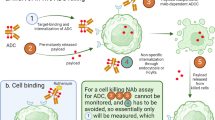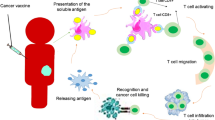Summary
In the perspective of therapeutic approaches the monoclonal antibody, MBr1, with a quite restricted spectrum of reactivity for human breast carcinoma, was coupled to restrictocin (Res), a ribosome inactivating protein produced by Aspergillus restrictus. In a cell-free system this toxin was found to have an activity comparable to that of other plant toxins, but its in vitro toxicity was shown to be low on different cell lines. Three batches of MBr1-Res conjugate were prepared and their specificity, efficiency, and maximum level of cytotoxicity were analyzed on the cell line MCF-7 expressing the relevant antigen, on several irrelevant tumor cell lines, and on normal cells. Conjugates were from 600 to 1500 times more efficient than the uncoupled derivatized Res towards MCF-7 cells and were completely ineffective on the other target cells. The antigen-driven cytotoxicity was confirmed by the nontoxicity of an irrelevant conjugate on MCF-7 cells. The cytotoxic efficiency of MBr1-Res was low when compared to the binding level of MBr1 at the same concentration and a portion of treated cells (from 10% to 30%) survived the treatment. The heterogeneity of expression of the relevant antigen, together with its only partial internalization, could account for these limitations. The lysosomotropic agent ammonium chloride and the carboxylic ionophore monensin were tested as potentiating agents but in both cases the cytotoxicity remained unmodified. A neutralization assay performed on a xenogenic model indicated that the MBr1-Res conjugate was capable of reducing the tumor take. These data indicate the possibility of using the Res to prepare a reproducible and highly selective breast cancer conjugate. However, there are still a number of problems which must first be solved before we can consider its clinical application.
Similar content being viewed by others
References
Barbieri L, Stirpe F (1982) Ribosome-inactivating proteins from plants: properties and possible uses. Cancer Surg 1:489
Bjorn MJ, Ring D, Frankel A (1985) Evaluation of monoclonal antibodies for the development of breast cancer immunotoxins. Cancer Res 45:1214
Bjorn MJ, Groetsema G, Scalapino L (1986) Antibody-Pseudomonas exotoxin A conjugates cytotoxic to human breast cancer cells in vitro. Cancer Res 46:3262
Bremer EG, Levery SB, Sonnino S, Ghidoni R, Canevari S, Kannagi R, Hakomori S-i (1984) Characterization of a glycolipid antigen defined by the monoclonal antibody MBrl expressed in normal and neoplastic epithelial cells of human mammary gland. J Biol Chem 259:14773
Canevari S, Fossati G, Balsari A, Sonnino S, Colnaghi MI (1983) Immunochemical analysis of the determinant recognized by a monoclonal antibody (MBr1) which specifically binds to human mammary epithelial cells. Cancer Res 43:1301
Canevari S, Orlandi R, Ripamonti M, Tagliabue E, Aguanno S, Miotti S, Ménard S, Colnaghi MI (1985) Ricin A chain conjugated with monoclonal antibodies selectively killing human carcinoma cells in vitro. J Natl Cancer Inst 75:831
Carlsson J, Drevin H, Axen R (1978) Protein thiolation and reversible protein-protein conjugation. Biochem J 173:723
Conde FP, Fernandez-Puentes C, Montero MTV, Vazquez D (1978) Protein toxins that catalytically inactivate ribosomes from eukaryotic microorganisms. Studies on the mode of a action of alpha sarcin, mitogillin and restrictocin: response to alpha sarcin antibodies. FEMS Microbiol Lett 4:349
Della Torre G, Canevari S, Orlandi R, Colnaghi MI (1987) Internalization of a monoclonal antibody against human breast cancer by immunoelectron microscopy. Br J Cancer 55:357
Endo Y, Huber PW, Wool IG (1982) The ribonuclease activity of the cytotoxin α-Sarcin. J Biol Chem 258:2662
Fernandez-Luna JL, López-Otin C, Soriano F, Méndez E (1985) Complete amino acid sequence of the Aspergillus cytotoxin mitogillin. Biochemistry 24:861
Fernandez-Puentes C, Carrasco L (1980) Viral infection permeabilizes mammalian cells to protein toxins. Cell 20:769
Filipovich AH, Vallera DA, Youle RJ, Quinones RR, Neville DM Jr, Kersey JH (1984) Ex vivo treatment of donor bone marrow with anti-T-cell immunotoxins for prevention of graft-versus-host disease. Lancet I:469
Forrester JA, McIntosh DP, Cumber AJ, Parnell GD, Ross WCJ (1984) Delivery of Ricin and Abrin A chains to human carcinoma cells in culture following covalent linkage to monoclonal antibody LICR-LOND-Fib 75. Cancer Drug Delivery 1:283
Frankel AE, Houston LL, Issell BF, Fathman G (1986) Prospects for immunotoxin therapy in cancer. Ann Rev Med 37:125
Greenwood FC, Hunter WM, Glover JS (1963) The preparation of 131I-labelled human growth hormone of high specific radioactivity. Biochem J 89:114
Laemli UK (1970) Cleavage of structural proteins during the assembly of the head of the bacteriophage T4. Nature 227:680
Lambert JM, Senter PD, Yau-Young A, Blattler WA, Goldmacher VS (1985) Purified immunotoxins that are reactive with human lymphoid cells. J Biol Chem 260:12035
LeMaistre CF, Edwards DP, Krolick KA, McGuire WL (1987) An immunotoxin cytotoxic for breast cancer cells in vitro. Cancer Res 47:730
Lin JY, Tserng KY, Chen CC, Lin K, Tung TC (1970) Abrin and Ricin: New antitumor substances. Nature 227:292
Lòpez-Otin C, Barber D, Fernandez-Luna JL, Soriano F, Méndez E (1984) The primary structure of the cytotoxin restrictocin. Eur J Biochem 143:621
Mariani-Costantini R, Colnaghi MI, Leoni F, Ménard S, Cerasoli S, Rilke F (1984) Immunohistochemical reactivity of a monoclonal antibody prepared against human breast carcinoma. Virchows Arch (A) 402:389
Ménard S, Tagliabue E, Canevari S, Fossati G, Colnaghi MI (1983) Generation of monoclonal antibodies reacting with normal and cancer cells of human breast. Cancer Res 43:1295
Olsnes S, Sandvig K (1983) Entry of toxic proteins into cells. In: Cuatrecasas P, Roth TF (eds) Receptor-mediated endocytosis. London, Chapman and Hall, 15:189
Olson BH, Goerner GL (1986) Alpha sarcin, a new antitumor agent. I. Isolation, purification, chemical composition, and the identity of a new amino acid. Appl Microbiol 13:314
Orlandi R, Canevari S, Leoni F, Mezzanzanica D, Ripamonti M, Colnaghi MI (1986) Change in binding reactivity of an anti-tumor monoclonal antibody after the introduction of 2-pyridyl disulphide groups. Hybridoma 5:1
Pirker R, Fitzgerald D, Hamilton T, Ozols R, Willingham M, Pastan I (1985) Anti-transferrin receptor-antibody linked to Pseudomonas exotoxin as a model immunotoxin in human ovarian carcinoma cell lines. Cancer Res 45:751
Ramakrishnan S, Houston LL (1984) Inhibition of human acute lymphoblastic leukemia cells by immunotoxins: potentiation by chloroquine. Science 223:58
Ripamonti M, Canevari S, Ménard S, Mezzanzanica D, Miotti S, Orlandi R, Rilke F, Tagliabue E, Colnaghi MI (1987) Human carcinoma cell lines xenografted in athymic mice: biological and antigenic characteristics of an intraabdominal model. Cancer Immunol Immunother 24:13
Tagliabue E, Porro G, Barbanti P, Della Torre G, Ménard S, Rilke F, Cerasoli S, Colnaghi MI (1986) Improvement of tumor cell detection using a pool of monoclonal antibodies. Hybridoma 5:107
Thorpe PE, Ross WCJ, Brown ANF, Myers CD, Cumber AJ, Foxwell BMJ, Forrester JT (1984) Blockade of the galactose-binding sites of ricin by its linkage to antibody. Eur J Biochem 140:63
Thorpe PE, Brown ANF, Bremner JAG Jr, Foxwell BMJ, Stirpe F (1985) An immunotoxin composed of monoclonal anti-Thy 1.1 antibody and a ribosome-inactivating protein from Saponaria officinalis: potent antitumor effects in vitro and in vivo. J Natl Cancer Inst 75:151
Uckun FM, Gajl-Peczalska KJ, Kersey JH, Houston LL, Vallera DA (1986) Use of a novel colony assay to evaluate the cytotoxicity of an immunotoxin containing pokeweed antiviral protein against blast progenitor cells freshly obtained from patients with common B-lineage acute lymphoblastic leukemia. J Exp Med 163:347
Youle RJ, Murray GJ, Neville DM Jr (1979) Ricin linked to monophosphopentamannose binds to fibroblast lysosomal hydrolase receptors, resulting in a cell-type specific toxin. Proc Natl Acad Sci USA 76:5559
Author information
Authors and Affiliations
Rights and permissions
About this article
Cite this article
Orlandi, R., Canevari, S., Conde, F.P. et al. Immunoconjugate generation between the ribosome inactivating protein restrictocin and an anti-human breast carcinoma MAB. Cancer Immunol Immunother 26, 114–120 (1988). https://doi.org/10.1007/BF00205603
Received:
Accepted:
Issue Date:
DOI: https://doi.org/10.1007/BF00205603




